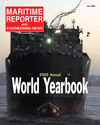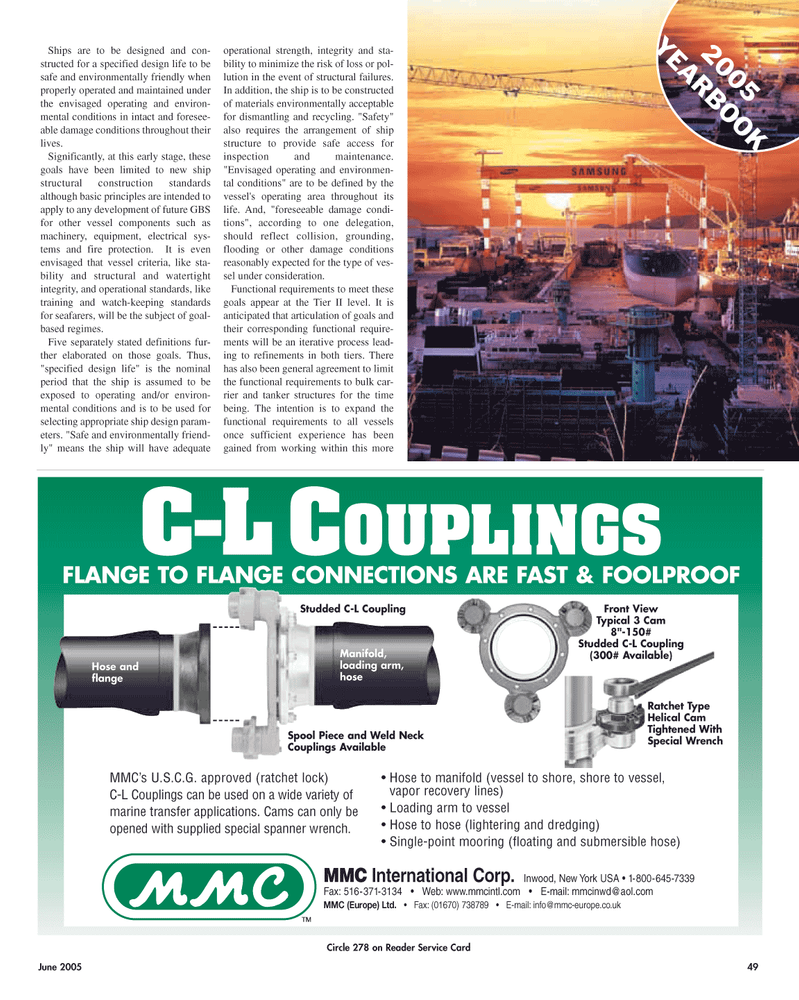
Page 49: of Maritime Reporter Magazine (June 2005)
Annual World Yearbook
Read this page in Pdf, Flash or Html5 edition of June 2005 Maritime Reporter Magazine
Ships are to be designed and con- structed for a specified design life to be safe and environmentally friendly when properly operated and maintained under the envisaged operating and environ- mental conditions in intact and foresee- able damage conditions throughout their lives.
Significantly, at this early stage, these goals have been limited to new ship structural construction standards although basic principles are intended to apply to any development of future GBS for other vessel components such as machinery, equipment, electrical sys- tems and fire protection. It is even envisaged that vessel criteria, like sta- bility and structural and watertight integrity, and operational standards, like training and watch-keeping standards for seafarers, will be the subject of goal- based regimes.
Five separately stated definitions fur- ther elaborated on those goals. Thus, "specified design life" is the nominal period that the ship is assumed to be exposed to operating and/or environ- mental conditions and is to be used for selecting appropriate ship design param- eters. "Safe and environmentally friend- ly" means the ship will have adequate operational strength, integrity and sta- bility to minimize the risk of loss or pol- lution in the event of structural failures.
In addition, the ship is to be constructed of materials environmentally acceptable for dismantling and recycling. "Safety" also requires the arrangement of ship structure to provide safe access for inspection and maintenance. "Envisaged operating and environmen- tal conditions" are to be defined by the vessel's operating area throughout its life. And, "foreseeable damage condi- tions", according to one delegation, should reflect collision, grounding, flooding or other damage conditions reasonably expected for the type of ves- sel under consideration.
Functional requirements to meet these goals appear at the Tier II level. It is anticipated that articulation of goals and their corresponding functional require- ments will be an iterative process lead- ing to refinements in both tiers. There has also been general agreement to limit the functional requirements to bulk car- rier and tanker structures for the time being. The intention is to expand the functional requirements to all vessels once sufficient experience has been gained from working within this more
June 2005 49 2005
YEARBOOK
Manifold, loading arm, hose
Spool Piece and Weld Neck
Couplings Available
Hose and flange
Studded C-L Coupling
C-L COUPLINGS
FLANGE TO FLANGE CONNECTIONS ARE FAST & FOOLPROOF • Hose to manifold (vessel to shore, shore to vessel, vapor recovery lines) • Loading arm to vessel • Hose to hose (lightering and dredging) • Single-point mooring (floating and submersible hose)
Front View
Typical 3 Cam 8"-150#
Studded C-L Coupling (300# Available)
MMC’s U.S.C.G. approved (ratchet lock)
C-L Couplings can be used on a wide variety of marine transfer applications. Cams can only be opened with supplied special spanner wrench.
MMC International Corp. Inwood, New York USA • 1-800-645-7339
Fax: 516-371-3134 • Web: www.mmcintl.com • E-mail: [email protected]
MMC (Europe) Ltd. • Fax: (01670) 738789 • E-mail: [email protected]
Ratchet Type
Helical Cam
Tightened With
Special Wrench
Circle 278 on Reader Service Card
MR JUNE 2005 #7 (49-56).qxd 6/2/2005 3:04 PM Page 49

 48
48

 50
50
